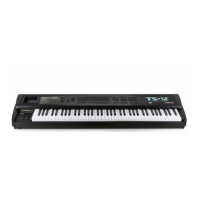TS-12 Musician’s Manual Section 7 — Effect Parameters
19
PRE-DLY TIME Range: 0000 to 0300 msec
This parameter creates a time delay before the original signal is fed into the reverb. The range is
based in milliseconds.
HF - DAMPING Range: 00 to 99
Controls the rate of attenuation of high frequencies in the decay of the reverberation. As natural
reverb decays, some high frequencies tend to get absorbed by the environment. Increasing the
value of this parameter will filter out increasing amounts of high-frequency energy.
BANDWIDTH Range: 00 to 99
Acts as a low pass filter on the signal going into the reverb, controlling the amount of high
frequencies that will pass into the effect. The higher the setting, the more high frequencies are
allowed to pass.
DEFINITION Range: 00 to 99
Controls the rate at which echo density increases with time. Higher values can cause the echo
density to build at a rate that exceeds the decay rate. For the best performance, try to select the
highest value that works with your sound source.
DIFFUSION Ranges: 00 to 99
These parameters determine whether the early reflections will appear as a series of discrete
echoes (lower values) or will be more diffused (higher values).
48 DDL- -CHORUS + REVRB 2
This effect algorithm, similar to the previous algorithm, offers a different reverb. For a complete
description of the SENDS, DDL, and CHORUS parameters, refer to the previous algorithm in this
section.
REVERB DECAY TIME Range: 0.40 to 140.0
Controls the amount of time it takes for the reverberation to decay to a low level (-60 dB) after the
input signal stops.
PRE-DLY TIME Range: 0000 to 0150 msec
This parameter creates a time delay before the original signal is fed into the reverb. The range is
based in milliseconds.
HF - DAMPING Range: 00 to 99
Controls the rate of attenuation of high frequencies in the decay of the reverberation. As natural
reverb decays, some high frequencies tend to get absorbed by the environment. Increasing the
value of this parameter will filter out increasing amounts of high-frequency energy.
BANDWIDTH Range: 00 to 99
Acts as a low pass filter on the signal going into the reverb, controlling the amount of high
frequencies that will pass into the effect. The higher the setting, the more high frequencies are
allowed to pass.
FRONT-TO-BACK LEVS (1 to 3) Ranges: -99 to +99
These three fields simulate the depth of the room/hall. Think of these fields as three different
microphones placed at various distances within the room/hall (the first is closest to the front, the
third is farthest from the front). When the range (volume) is higher for the first value, the sound
appears closer to the front, whereas a higher setting for the last value appears farther from the
front, suggesting a deeper (wetter) room/hall.

